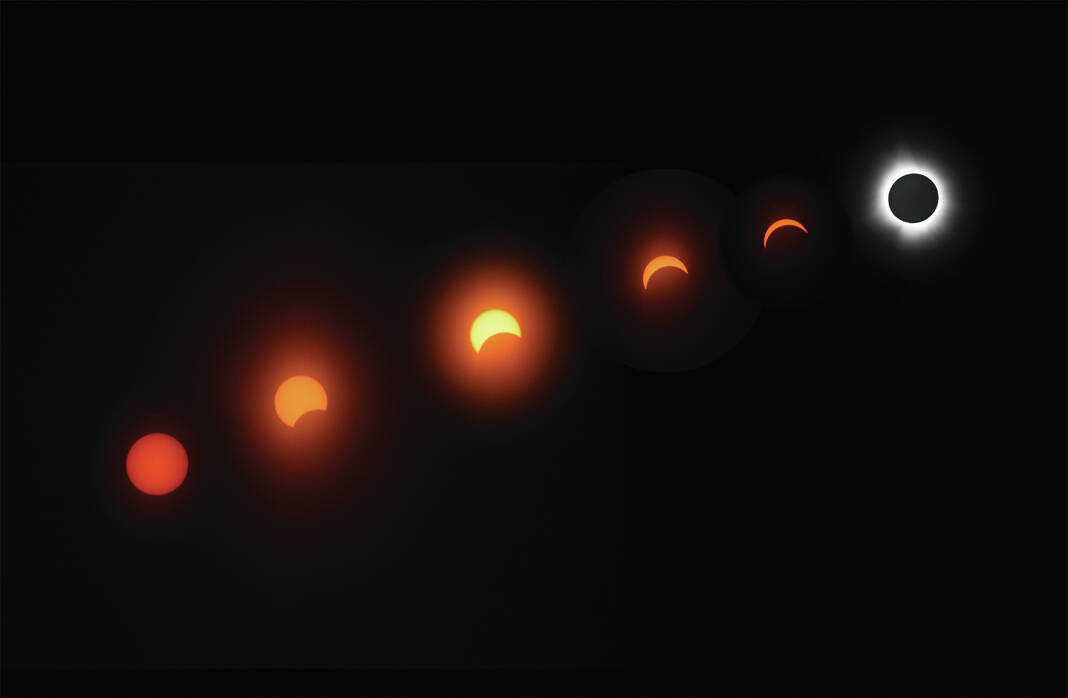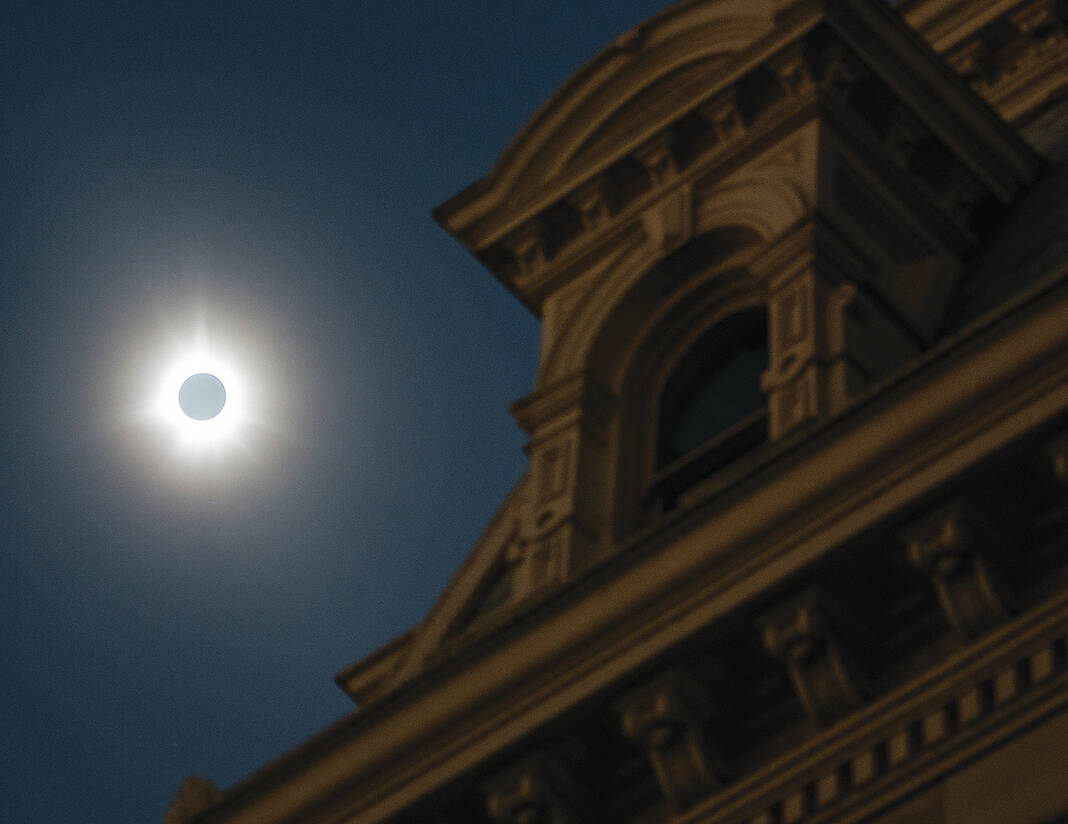
A collage of the sun at different stages leading up to totality during the eclipse, as viewed from the Sidney Courthouse lawn on Monday, April 8. Over 200 people gathered on the Courtsquare to watch the event. Sidney Alive had a tent on the Northwest corner for the Courthouse lawn and played sun- and moon-themed music. No major incidents were reported by the Shelby County Emergency Management Agency, and eclipse viewing events went off without a hitch. Totality started at 3:09 p.m. and ended a little less than four minutes later. Crowds were light throughout Sidney, and most travelers departed soon after totality.
Luke Gronneberg | Sidney Daily News

A view to totality during the solar eclipse on Monday afternoon, as seen from the Shelby County Courthouse lawn. Totality lasted a little under four minutes. Most of the people who gathered on the Courtsquare left soon after totality.
Bryant Billing | Sidney Daily News
SIDNEY — Mother Nature cooperated throughout the region on Monday, providing mostly clear skies for total solar eclipse viewers in the afternoon. No major incidents were reported, and eclipse day viewing plans went off without a hitch, including in downtown Sidney.
Over 200 people watched the eclipse on the courtsquare, many of which were travelers. Among them were Steve Sirotzky and Rachel Piate, who both traveled from different parts of Virginia.
Piate, of Alexandria, Virginia, brought a telescope and set it up on the Shelby County Courthouse lawn to view the eclipse. She said she originally planned to drive to the Armstrong Air and Space Museum in Wapakoneta but changed her mind and wanted to go to an isolated park in order to also observe the wildlife’s reactions.
She tried several parks, all of which were closed. She stumbled into Sidney and settled on the courtsquare to view the eclipse.
Sirotzky, of Falls Church, Virginia, is a NASA engineer and works at the Goddard Space Flight Center in Greenbelt, Maryland. He brought a tripod and hung a colander from it, which created eclipse shadows through the holes of the colander on a piece of paper on the ground.
He also brought NASA-branded activity books for children and gave them to Sidney Alive, which had a tent on the northwest corner of the square and played music throughout the afternoon. The organization gave them away and also provided eclipse viewing glasses to any who didn’t have them.
Viewers on the square set up lawn chairs and blankets and stayed through totality. Cheers erupted when totality started at 3:09 p.m., and the loudest cheers came at the end during the diamond ring phenomenon, when the sun began to shine through valleys and mountains on the edge of the moon.
Most viewers packed up and left soon after totality ended, which was a little before 3:15.
Crowds were generally light throughout Sidney. The Shelby County Fairgrounds, Sidney High School and VanDemark Farm were among local organizations and businesses who were offering day-of parking to travelers for the event; the fairgrounds and VanDemark Farm also offered camping over the weekend.
Sidney High School’s athletic booster groups jointly ran the eclipse viewing event on its campus. Sidney Memorial Stadium and all athletic fields were open to viewers, and the booster group operated concession stands.
Renee Davis, the boys basketball booster president, said over 120 parking spots had been sold through online presale. The booster groups also passed out flyers at local hotels (which were at capacity) in hopes of attracting more day-of viewers.
The largest crowds locally were at Lake Loramie State Park, which was on the center line of totality. The Ohio Department of Natural Resources reported the park reached capacity before 2 p.m.; the spillway parking lot and beach parking lot both filled up before 11 a.m. Campgrounds at the park sold out months in advance.
Several state parks were in the path of totality, including other regional parks like Indian Lake, Kiser Lake and Grand Lake St. Marys. The ODNR reported Indian Lake also reached capacity on Monday.
No major incidents, traffic or otherwise, were reported by the Shelby County Emergency Management Agency. Area businesses saw an uptick from travelers, but no one was overwhelmed, as crowds dispersed shortly after totality.
Regionally, crowds formed from Springfield to Lima. An estimated 2,000 people were on the grounds of the Armstrong Air and Space Museum in Wapakoneta, and crowds also gathered at other aviation museums in the region, including WACO Air Museum in Troy and in Dayton at the National Museum of the U.S. Air Force and Dayton Aviation Heritage Park.
Planned activities throughout the weekend also occurred without incident in Shelby County. The fairgrounds had food trucks from Friday through Monday, and Sidney Alive organized several events, including a concert by a Pink Floyd tribute band at the Historic Sidney Theatre on Sunday.
The total solar eclipse was the first to pass over Ohio since 1806, and the next will not occur until 2099. The next total solar eclipse to occur over the contiguous United States won’t occur until 2044, and totality will only be visible on North and South Dakota and Montana.
The next total solar eclipse to pass over a large portion of the country will be on Aug. 12, 2045. The path of totality will stretch from California to Florida.
Sidney Daily News chief photographer Luke Gronneberg contributed to this report.

